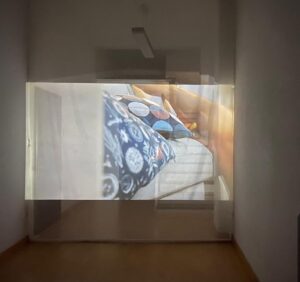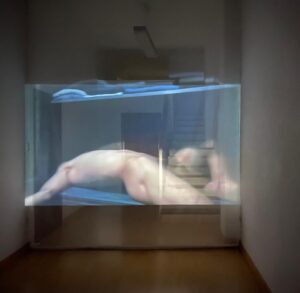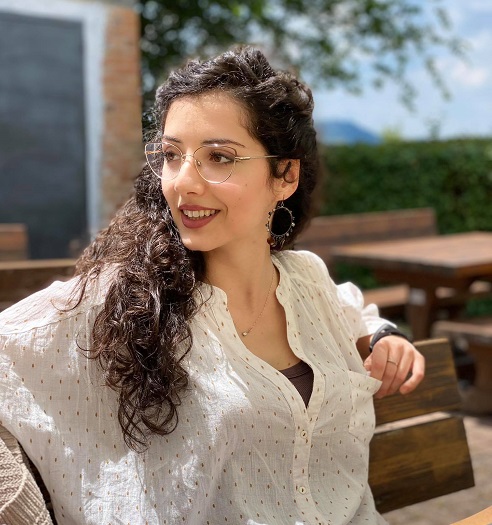You may happen to walk the streets of Bologna, find yourself in via del Porto and come across, at number 48 / CD, a closed shutter. So far, nothing new. Especially in this historical moment, “closed” seems to be an extremely recurring word. If you get closer, however, you will notice that there is a particular crack on the shutter, which invites you to look through to discover the art that lies beyond the closure.
This is Close (), an exhibition project curated by PARSEC, a collective made up of 11 girls (curators, artists, art historians, cultural operators) who inaugurated their cultural space in October 2020 with Put yourself out there, an event which explored the theme of play as a free field of action. PARSEC stands for parallax of one second of arc; it indicates the apparent angular displacement of an object when viewed from two different points of view.
What the oldest and most reliable method of measuring stellar distances has to do with the newborn artistic and cultural space in Bologna is explained in the PARSEC Manifesto itself: However, this divergence is not only subjective, observing and observed are intrinsically “mediated”: the subject’s gaze is already in the observed object. So reality depends on our own construction, but we are constantly included in the images we create. It is in this reflective short circuit, in this splitting of ourselves into something that is inside and outside the image, that our being in the world manifests itself. The reality we see therefore is never “whole”, there is always a blind spot in which we are included in it.
Parsec is not just an exhibition place, but a space of participatory and fluid culture, open to practical and theoretical confrontation. In fact, it arises from the need to reflect on the role and responsibilities of contemporary art and – before the provisions regarding the suspension of cultural activities – the program included artistic residencies and workshops, as well as exhibitions. Faced with the complications that inevitably affect the whole world of culture in this period, Parsec decides to reinvent itself with CLOSE (). So yes, it closes – temporarily – the shutter of the space, but thinks of an alternative that makes the works of the young artists with whom it collaborates accessible, in safety. The crack brings out what would otherwise remain hidden.
After the Iside Calcagnile exhibition, it is Gloria Dardari‘s turn with her video installation Dhomus. She is a young artist based in Bologna, she begins to work in the film and television sector as a set designer. This influences her artistic practice: through photography, video and installations, she tries to make concrete and mental spaces dialogue. This is what also happens in Dhomus, in the concrete rooms of a house the naked body of a man is abandoned to a state in the balance between life and death. The body appears lifeless, slumped dangling in the silence of the domestic environment, yet it breathes, it is alive. Through the work, the artist reflects on her personal image, looks outside herself and gets rid of her own subjectivity. A physical and psychological process at the same time, which makes Dardari spectator and actress of that breath that still moves the laid limbs.
Close () does not stop at the display of the installations visible through the crack, but imagines these as the starting point from which to give rise to reflections and ideas, in the form of online insights made available to the public. The in-depth study proposed for Dhomus entitled “In free fall” is interesting, which includes a series of excerpts from texts by different authors, combined with images taken from the world of art. Some illustrations by one of the founders of Parsec, Giulia Monte, recall the various “stages” that the body assumes in Dhomus.
From Hito Steyerl who talks about falling as something relational (if there is no ground towards which to fall then one remains in a state of suspension) to Giovanni Bitetto who in “Scavare” talks about how you die a little every day from the psychological phenomenon of the uncanny (unheimlich) that can corresponds to imagining the moment of one’s death, to Bill Viola who talks about the mortality of the image: “Finally, there is nothing, when the plug is unplugged and the device is turned off. In analogy with our body this would correspond to closed eyes, sleep and death”.
A series of interesting ideas that are reflected in the set of images linked, in some way, to Dardari’s work. Peering into the crack to discover ourselves immersed in Dhomus is not so different from what Duchamp had imagined in Étant donnés; Hippolyte Bayard in La noyade stages his death and creates the first photographic staging in history; the abandonment of Meleager’s arm, which returns several times in the Depositions of Christ, is the same tragic abandonment of the body of Dhomus. It is a series of references: from one image to a thought to another image and then to contemporary reality. Why don’t we all feel a little bit, at this moment, in free fall? The work and the insights are a good opportunity to stop, get closer, peek deeply into ourselves and – as far as possible – react to the condition of closure and distance we are experiencing.
Ornella D’Agnano
Info:
Gloria Dardari. Close ()
19 dicembre 2020 – gennaio 2021
Parsec
via del Porto 48 c/d, Bologna
 Progetto CLOSE ( ), PARSEC, Via del Porto 48/CD
Progetto CLOSE ( ), PARSEC, Via del Porto 48/CD
 Gloria Dardari, Dhomus. Video 4’55 in loop, 2019
Gloria Dardari, Dhomus. Video 4’55 in loop, 2019
 Gloria Dardari, Dhomus. Video 4’55 in loop, 2019
Gloria Dardari, Dhomus. Video 4’55 in loop, 2019
 Gloria Dardari, Dhomus. Video 4’55 in loop, 2019
Gloria Dardari, Dhomus. Video 4’55 in loop, 2019

Born in Puglia (Italy), after a three-year degree in Cultural Heritage at the University of Salento (Lecce), she deepened her study of contemporary art, graduating in Visual Arts at the University of Bologna, where she currently lives and works. Author of the critical essay “Museum and Neutrality”. Member of the Muri di Versi Cultural Association. She believes that art is a powerful tool capable of arousing reflections and creating relationships.






NO COMMENT